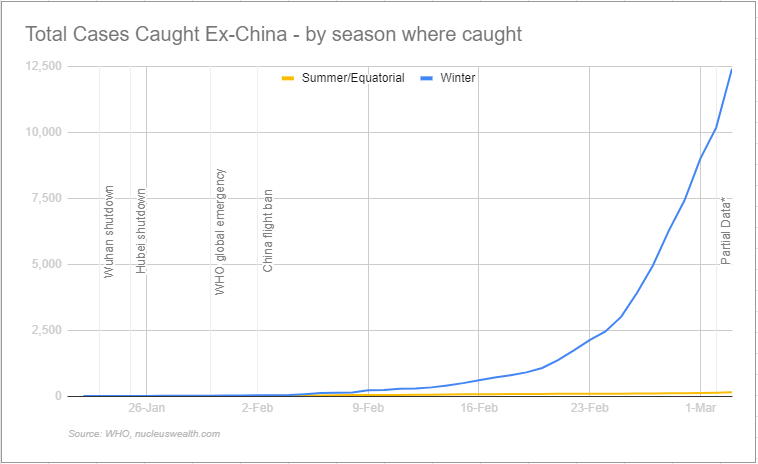Amid the inane squawking of the Australian political economy pet shop there was one moment worth mentioning from the weekend. That gong goes to Gladys Berejiklian who inadervently described the unfolding calamity, at Domain:
“There is no doubt that we are not anywhere near the worst of this,” she said. “We haven’t even hit the winter months.”
That simple statement is all that matters. COVID-19 appears to be a Winter virus:

So, the good news is that Australia should be able to keep the virus under control for a few months yet with the help of light, heat and humidity. So long as we introduce social distancing measures like cancelling the Women’s Criket World Cup final and Australian Grand Prix….whoops…
The bad news is, that makes us one of the worst positioned countries on earth economically. Why?
Because the northern hemisphere pandemic will peak in May and begin to subside with the onset of Summer. But the recovery from shut downs will be slow, as we are already seeing in China, as shell-shocked consumers worldwide creep out of their bunkers.
So, by mid-year, we expect the global economy to be a full blown recession, with negative growth shocks on the scale of the GFC, a huge stock market bust and equally large corporate debt crisis.
And this is where it turns ugly. Just as this shock lands upon the Australian economy, the virus itself will erupt in earnest as it gets colder. This will shut down large swathes of Australia until deep Spring. You have to make a leap of imagination to understand how profound this is. For three months:
- all schools and universities shut;
- malls deserted;
- all but emergency services constrained;
- all enterntainment closed;
- AFL, NRL and Olympics cancelled (or no crowds at best);
- mass staff shortages;
- global bans on Australians travelling.
This will put the Autralian economy into an unprecedented freeze and growth will crater.
Corporations will be OK. They will issue equity en masse. Though their shareholders will be smashed.
The real problem is going to come from the SME sector and, I suspect, the banks. The above scenario will involve mass buinesss failures and defaults. Perhaps like the 1990s recession.
As unemployment spikes, it is inconceivable that house prices won’t also begin to fall.
So banks are going to see major deflation in their collateral, major losses in loans, major rises in their offshore funding costs and, as the RBA cuts again, further big falls in their margins. They’ll need bailouts.
There is no recognition yet of any of this in policy circles. The Morrison Government has been slow to react at the border, is talking only about a “health not financial crisis” with small scale stimulus and wasted money for interests.
The RBA has underestimated the event from the start and is again miles behind the curve. It should already be at a zero cash rate and have launched QE to keep banking funding costs as low as possible plus smash the currency.
The trivialised media pointlessly gawks at shelves stripped of toilet paper rather than debate how to mitigate the looming calamity. One of the good things to come out of the crisis may be its collapse and rebirth.
Which brings me to my last point. Australian institutions from coast-to-coast are about to be stressed by a once per century shock of a scale unseen since WW2. Health, law enforcement, business, government at every level, will be stretched to its utmost capability.
We have spent twenty years degrading most of it. Let’s hope it started from a high enough point that it can still cope.
In a few very short months we will know.

